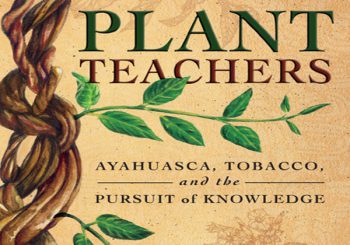By Kim Corbin
Guest Writer for Wake Up World
“The dose makes the poison,” says an old adage, reminding us that all substances have the potential to heal or to harm, depending on their use.
This is especially true of tobacco, according to the new book Plant Teachers: Ayahuasca, Tobacco, and the Pursuit of Knowledge (New World Library, September 1, 2021), in which anthropologist and bestselling author Jeremy Narby joins with indigenous elder Rafael Chanchari Pizuri to hold a cross-cultural dialogue that explores the similarities between ayahuasca and tobacco, the role of these plants in indigenous cultures, and the hidden truths they reveal about nature. Here’s a short Q & A with Jeremy about the book.
[pro_ad_display_adzone id=”110028″]
What was your intention behind writing Plant Teachers? Are you encouraging readers to try tobacco and/or ayahuasca?
No, we wanted to make available a wide range of knowledge about these two powerful plants so that those who decide to use them know what they are getting into.
Tell us about your co-author Rafael Chanchari Pizuri and how you came to work together.
Rafael was chosen by the Shawi people to teach their language and culture at a school for young indigenous teachers. He has worked with plants like tobacco and ayahuasca all his life. He knows as much about “indigenous knowledge” as anybody I know.
What does it mean to say that a plant can teach?
It can mean different things to different people, depending on your view of the world. Amazonian people tend to personify plants, and see them as living entities with intentions and points of view. In their view, when you ingest a teacher plant like ayahuasca or tobacco, the plant manifests itself to you in your body and mind, and you learn things, about yourself and the world around you.
From a scientific point of view, which objectifies rather than personifies, it means that the plant contains psychoactive molecules that may act as enhancers of cognition or stimulants of creativity.
What have you learned from plants on a personal level?
Too much to list in a single paragraph. I’ve written entire books while inspired by plants. Most of the paragraphs I’ve written have been edited by plants, meaning that I have consumed plants, allowed them to inspire me, and then done the editing.
You talk about tobacco actually being a medicinal drug, flying in the face of received opinion about the dangers of cigarettes. Is it a question of the purity of the drug or is it a question of the way in which it is consumed?
Both. Obviously, industrial cigarettes are laced with hundreds of chemical additives, whereas therapeutic tobacco as used by Amazonian shamans needs to be pure. In the Amazon, the plant is used as a poultice, and an analgesic; applying tobacco to the wounded part of the body is the foremost healing practice in the region. Meanwhile, science, too, is finding medical applications for tobacco and nicotine. That said, consuming tobacco remains a risky venture.
Tell us more about the tobacco’s medicinal qualities. What does it help heal?
Nicotine can stimulate the growth of new blood vessels, and it may also attenuate Parkinson’s disease, Alzheimer’s disease, as well as help people suffering from schizophrenia. It can also function as a painkiller in certain circumstances. All this is the subject of on-going research.
In the book you say that scientists only recently began considering nicotine, or tobacco, to be a hallucinogen. What caused that shift to happen?
Until recently, they based their view on Virginia-type tobacco, which is relatively weak in nicotine. When they understood that dark Amazonian tobacco is much more powerful, and when they took into consideration the testimonies and practices of Amazonian shamans, they began to consider the plant as a potential hallucinogen.
Did you discover any frictions between the scientific and indigenous views when it comes to tobacco?
Yes, for example, the shamanic view of the plant as a teacher does not sit well with scientific observers, because of its implicit animist roots.
Is the current enthusiasm for ayahuasca warranted?
In part, because the plant mixture does show a considerable therapeutic potential.
Can ayahuasca be used to abuse people?
Unfortunately, yes. Drinking ayahuasca takes your defenses down, and makes you vulnerable. Some people take advantage of this, and so people need to be forewarned.
Did anything in your ayahuasca research surprise you?
I have not ceased to be surprised from day 1. Trying to understand ayahuasca has taught me an enormous amount about the human body and mind, and about the astonishing capacities of plants. Most of the big questions concerning ayahuasca remain unanswered.
You share an anecdote in the book about a shaman transforming into a jaguar. Then you say when you first tried pure tobacco paste you felt you grew feline whiskers and started to eye up the chickens as food, only deterred by being an anthropologist. Was this auto-suggestion or were you really being transformed by the drug?
My view is that strong shamanic tobacco causes a rush of adrenaline and other hormones in one’s body and brain, so that one feels a combination of warmth, aggressivity, calm, and quick thinking, all in one. These feelings have nothing to do with auto-suggestion. But when one then goes on to interpret this unusual mix of emotions and body-based impressions, one may indeed convoke ideas or images that one has been carrying around, if only to make sense of what one is experiencing. Whether this last part qualifies as “auto-suggestion,” I am not sure. Perhaps.
Is it possible to bring together two systems of knowledge that are as different from one another as science and indigenous shamanism?
Yes, and this is what our book attempts to demonstrate. By reading it, you can make up your own mind on the question. In my view, as long as one understands and respects the differences between the two systems of knowledge, a mutually-enriching dialogue is possible.
Were you surprised by the correspondences you discovered between indigenous knowledge and contemporary science in your research for the book?
Yes, I was surprised by the extent to which contemporary science backs up numerous indigenous notions concerning tobacco and ayahuasca.
What advice would you have for people who smoke tobacco?
Learn more about the plant, be careful which tobacco you smoke, and pay attention to where and why you smoke the plant.
What should people know before drinking ayahuasca for the first time?
They need to know about their own health situation, their own motivations, the person who will be administering the brew, just what the brew contains, the legal context in which the ayahuasca drinking will occur, and so on. Drinking ayahuasca is a complex act. It’s important not to take it lightly.
# # #
 Jeremy Narby, PhD, is the coauthor of Plant Teachers with Rafael Chanchari. He became an early pioneer of ayahuasca research while living with the Ashaninca people of the Peruvian Amazon in the 1980s. He studied anthropology at Stanford University and now lives in Switzerland and works as Amazonian projects director for Nouvelle Planète, a nonprofit organization that promotes the economic and cultural empowerment of indigenous peoples.
Jeremy Narby, PhD, is the coauthor of Plant Teachers with Rafael Chanchari. He became an early pioneer of ayahuasca research while living with the Ashaninca people of the Peruvian Amazon in the 1980s. He studied anthropology at Stanford University and now lives in Switzerland and works as Amazonian projects director for Nouvelle Planète, a nonprofit organization that promotes the economic and cultural empowerment of indigenous peoples.
[pro_ad_display_adzone id=”110027″]







